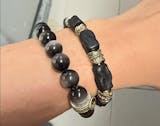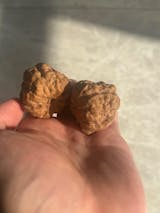The Philosophy of Yin-Yang and the Five Elements in Ne Zha Movie
Introduction
Ne Zha:Demon Child Conquers the sea is an animated film that has captivated audiences worldwide with its stunning visuals and compelling story. Beneath the surface, however, the movie is steeped in Chinese traditional cultural elements, particularly the philosophical concepts of Yin-Yang and the Five Elements, as well as the Chinese metaphysical theory of Ba Zi.

The Concept of Yin and Yang: Dialectics in Characters and Destiny
Yin-Yang, one of the fundamental concepts in ancient Chinese philosophy, represents the dual forces of the universe that are opposites yet complementary. In Ne Zha, the idea of Yin-Yang permeates the narrative, influencing the characters' traits and the progression of their destinies.
Ne Zha and Ao Bing: The Opposite Forces of Yin and Yang
- Ne Zha, born from a magical egg, embodies the Yin force. He is naturally rebellious, impulsive, and often acts with extreme energy, characteristics traditionally associated with Yin. However, this intense Yin energy also provides Ne Zha with the strength to challenge and eventually transcend his fate.
- Ao Bing, in contrast, represents the Yang force, symbolizing the reincarnation of the Dragon King's son. Ao Bing is calm, rational, and cultured, yet his Yang energy makes him overly obedient to his family’s wishes, often suppressing his own desires.
- Throughout the film, the interaction between Yin and Yang is evident. These forces are not static but transform, shift, and coexist. Ne Zha and Ao Bing’s destinies are intertwined through this dynamic interplay of Yin and Yang, leading to their ultimate collaboration despite their contrasting nature.

The Five Elements: How They Define Character Traits and Fate
The theory of the Five Elements (Wood, Fire, Earth, Metal, and Water) is another cornerstone of Chinese philosophy, each element representing certain qualities and principles. In Ne Zha, the characters' personalities and fates align with these five elements, adding another layer of depth to the story.
-
Fire: Ne Zha’s Fiery Temper and the Threat of Self-Destruction
Ne Zha's character mirrors the qualities of Fire. The Fire element is often associated with strength, passion, and volatility, but also with the potential for self-destruction. Ne Zha’s explosive personality and intense energy make him prone to rash actions and anger, often leading to chaos. However, this Fire energy also drives him to resist his tragic fate, ultimately allowing him to rewrite his destiny. -
Water: Ao Bing’s Calmness and Noble Character
Ao Bing exemplifies the Water element. Water represents adaptability, calmness, and wisdom, yet also signifies passivity and submission. Ao Bing is depicted as a calm and noble character who appears to be in control of his emotions and rational in his decisions. However, his adherence to the expectations of his family reflects the passive and yielding nature of Water, which sometimes makes him seem weak and indecisive. -
Metal: Shen Gongbao’s Strength and Ruthlessness
Shen Gongbao is a character who embodies the Metal element. Metal symbolizes strength, persistence, and also harshness. In the film, Shen Gongbao’s actions are calculated and ruthless, as he uses any means necessary to achieve his goals. His unyielding pursuit of power showcases Metal’s attributes of endurance and the will to succeed, even through morally questionable paths. -
Wood: Master Li’s Benevolence and Potential for Growth
Master Li, who trains Ne Zha, reflects the qualities of Wood. Wood represents growth, expansion, and nurturing, but it can also signify arrogance and unchecked expansion. Master Li is benevolent and wishes to help Ne Zha grow, but his personal flaws—especially his jealous and insecure nature—also hinder his ability to fully support Ne Zha in his growth. This duality in Master Li’s character reveals the complexities of Wood energy, where good intentions sometimes lead to destructive consequences.

The Interplay and Transformation of Yin-Yang and the Five Elements
The interaction and transformation between Yin-Yang and the Five Elements are pivotal to understanding the changes in the characters’ personalities and destinies. Each character’s journey and transformation are deeply influenced by these philosophical concepts.
-
Yin-Yang Transformation: Turning Points in Character Fates
Ne Zha and Ao Bing’s character arcs exemplify the Yin-Yang transformation. Ne Zha’s transition from a rebellious and destructive force to a more responsible and heroic figure represents Yin transforming into Yang. Conversely, Ao Bing evolves from being a passive, obedient character to someone who asserts his individuality, symbolizing Yang transforming into Yin. This shifting dynamic of Yin and Yang leads to a harmonious resolution, where the two characters cooperate and ultimately change their fates. -
Five Elements Flow: The Shifting Nature of Character Traits
Shen Gongbao and Master Li’s characters undergo transformations influenced by the Five Elements. Shen Gongbao’s growth from a vengeful and power-hungry figure to a more reflective and remorseful one mirrors the transition of Metal into Water, where rigidity softens and yields to introspection. Master Li’s change from a wise mentor to a more flawed and jealous figure reflects Wood transforming into Metal—growth that eventually leads to a stagnation or corruption of the initial intention.

Conclusion
Ne Zha is more than just an action-packed animated film. Through the lens of Yin-Yang and the Five Elements, the movie delves into the complex philosophies of fate, personality, and the balance of opposites. These concepts not only drive the plot but also provide deep insight into the characters' inner struggles and transformations.
The film’s portrayal of Yin-Yang and the Five Elements reminds us that life itself is full of opposing forces that can either conflict or complement each other. Just as the characters in Ne Zha undergo profound transformations, so too can we understand that our own lives are shaped by the ebb and flow of these forces.
✨Just as Nezha and Ao Bing embody the balance of fire and water in the Five Elements, you too can carry this harmony with you—explore our Nezha & Ao Bing inspired bracelets.
Related articles:
The Balance of Yin and Yang in Nezha Movie: Symbolism and Philosophy
How to Interpret the Traditional Chinese Cultural Elements in Ne Zha 2?
The Seven-Colored Sacred Lotus: Ne Zha's Soul, Rebirth, and Symbolism


























































